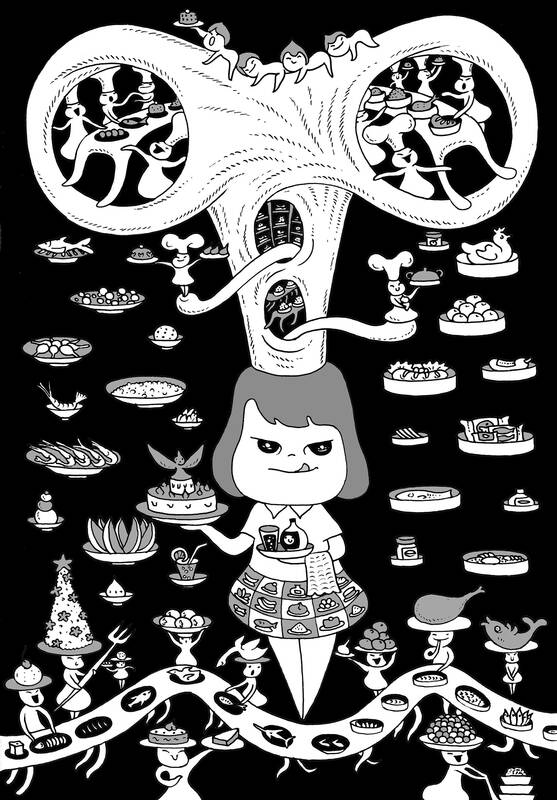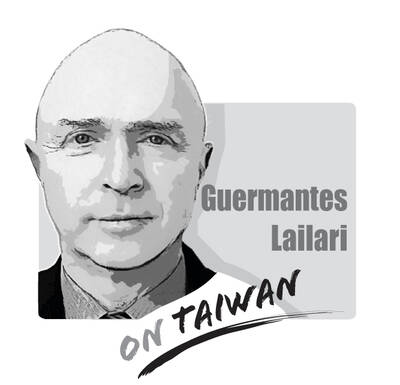Ultra-processed foods, or UPFs for short, are suddenly the hot health concept — the new antihero in global diets. The topic is exploding both in scientific literature and on social media. There is even an artificial intelligence (AI) system to help consumers select less-processed foods while shopping.
But once you get past the important and obvious idea that junk food is harmful, the concept of ultra-processed becomes hazy and confusing.
There is unprocessed, processed, culinary ingredients and ultra-processed. So, what is the consumer supposed to do?

Illustration: Mountain People
NOVA, the most widely used system for categorizing food as ultra-processed, includes everything from doughnuts to frozen dinners. The unprocessed category includes fresh vegetables; culinary ingredients include things such as sugar, cooking oil and flour. Then there are the merely processed items, which include things like canned chickpeas, pasteurized milk and plain yogurt.
Under this system, a frozen dinner made with healthy ingredients such as fish and broccoli might fall into the ultra-processed category, but not a homemade cake with lots of sugar. There is no real evidence that a pizza made at home is better than a frozen store-bought one with the same ingredients. And if it is the ingredients that matter, would consumers not be better off with a science-based guide to which ingredients are harmful?
The ultra-processed classification system comes from Brazil, where Nestle, sensing the market potential, flooded the country with packaged food. What followed was a corresponding increase in obesity and diabetes, although food industry executives justified the action by pointing out that the move decreased hunger.
Telling people to avoid ultra-processed foods is a big improvement compared with simply advising them to avoid high-fat foods and eat low-fat versions of things like yogurt, ice cream, energy bars and cereal — which are usually high in sugar. Agreement on the dangers of a diet high in sugar is a rare area of common ground in the contentious science of nutrition. The medical community could go a long way in improving Americans’ health by helping them cut back in this area. From there, it is important to keep studying, which is the biggest threat posed by ultra-processed foods — whether it is in the oils, the additives or the processing itself.
Many ultra-processed foods are popular, because they have a long shelf-life, tend to be cheaper and are convenient for people who do not have time to cook. Scientists could help alleviate some chronic diseases and food insecurity by figuring out how to make the convenience foods we love healthier. More scientific research is also needed to determine which of the so-called ultra-processed foods are the worst for us.
The best case against ultra-processed food comes from several studies that followed large populations and found correlations between the heavy consumption of these foods and poor health outcomes, including more heart disease and cancer. The same group also tends to have lower incomes, smoke and lead more sedentary lifestyles, so epidemiologists must try to tease out all these factors.
One of the most influential studies confined test subjects to a food lab for several weeks and monitored everything they ate. The results were mixed. People gained weight on higher-calorie ultra-processed foods — chicken nuggets, fries, sugary drinks — that are considered “hyper-palatable” because they taste good. They lost weight eating other ultra-processed foods like liquid eggs, flavored yogurt and oatmeal, turkey bacon, and burrito bowls with beans.
The conclusion: The category of ultra-processed alone was not enough to predict health outcomes, even in the short term.
Another recently released study attempted to use brain scans to test the popular theory that ultra-processed foods are addictive and give people a dopamine surge similar to cocaine. The research found no such correlation, though the authors contend that this does not disprove the addictiveness of foods.
I was skeptical of the dogma that ultra-processed foods taste better than homemade — something that would obviously depend on the skill of the person doing the cooking. Everyone I know prefers homemade food, and home-cooked items always go first at potlucks I have attended.
Dariush Mozaffarian, director of the Food is Medicine Institute at Tufts University, agreed that homemade dishes are often tastier than the store-bought equivalents. However, in some ways, they are less satisfying, and might therefore compel people to eat more not out of pleasure, but some other impulse, he said.
Mozaffarian is looking into the health effects of some of the ingredients that regularly show up in ultra-processed foods, such as artificial emulsifiers. These ingredients make ice cream and mayonnaise creamy, but might also have a deleterious effect on our microbiomes — the bacteria that live in our guts.
Others have pointed to the cheap fats used in ultra-processed foods — especially soybean oil. That has been the subject of a longstanding war between epidemiologists, who say soybean oil is good for us, and some biochemists, who see excess amounts of these oils interfering with our body’s ability to use and incorporate healthy omega-3 fatty acids. The biochemists point to the dramatic rise in industrial oils in the 20th century and wonder if we are still guinea pigs in an ongoing experiment.
For years, we were told that the saturated fat found in many unprocessed foods such as whole milk, full-fat yogurt, cheese and meat caused heart disease. However, several newer analyses of the scientific literature call that link into question. Mozaffarian said new studies show that people who eat full-fat dairy products are healthier than those who choose low-fat or nonfat versions.
Another recent study showed an association between longevity and the consumption of vegetable oils and a slight decrease in longevity associated with butter, but only in people who were already unhealthy and not if the butter was used for cooking and baking. It was hard to know what conclusion to draw.
Others are looking at the processing itself. Laszlo Barabasi, a network scientist at Northeastern University, said most plants and animals contain the same ratio of basic nutrients — fats, carbohydrates, protein and vitamins. In his theory, the more a food product deviates from that natural ratio, the more ultra-processed it is. Using that concept, his group trained an AI system to examine the proportions of 15 components listed on food labels to determine where they fall on an ultra-processed food spectrum. This could be useful in future studies, but has not yet been connected with specific health impacts.
Food is personal, and scientists’ views get tied up in their environmental, ethical and spiritual feelings, especially on the choice between eating unprocessed meat and dairy and more processed meat substitutes. On the bright side, multiple lines of evidence show most of us would be healthier eating less sugar. That is a good start. And then we need more and better research to sort out the rest.
F.D. Flam is a Bloomberg Opinion columnist covering science. She is host of the Follow the Science podcast. This column does not necessarily reflect the opinion of the editorial board or Bloomberg LP and its owners.

A foreign colleague of mine asked me recently, “What is a safe distance from potential People’s Liberation Army (PLA) Rocket Force’s (PLARF) Taiwan targets?” This article will answer this question and help people living in Taiwan have a deeper understanding of the threat. Why is it important to understand PLA/PLARF targeting strategy? According to RAND analysis, the PLA’s “systems destruction warfare” focuses on crippling an adversary’s operational system by targeting its networks, especially leadership, command and control (C2) nodes, sensors, and information hubs. Admiral Samuel Paparo, commander of US Indo-Pacific Command, noted in his 15 May 2025 Sedona Forum keynote speech that, as
Chinese Nationalist Party (KMT) Chairman Eric Chu (朱立倫) last week announced that the KMT was launching “Operation Patriot” in response to an unprecedented massive campaign to recall 31 KMT legislators. However, his action has also raised questions and doubts: Are these so-called “patriots” pledging allegiance to the country or to the party? While all KMT-proposed campaigns to recall Democratic Progressive Party (DPP) lawmakers have failed, and a growing number of local KMT chapter personnel have been indicted for allegedly forging petition signatures, media reports said that at least 26 recall motions against KMT legislators have passed the second signature threshold
The Central Election Commission (CEC) on Friday announced that recall motions targeting 24 Chinese Nationalist Party (KMT) lawmakers and Hsinchu Mayor Ann Kao (高虹安) have been approved, and that a recall vote would take place on July 26. Of the recall motions against 35 KMT legislators, 31 were reviewed by the CEC after they exceeded the second-phase signature thresholds. Twenty-four were approved, five were asked to submit additional signatures to make up for invalid ones and two are still being reviewed. The mass recall vote targeting so many lawmakers at once is unprecedented in Taiwan’s political history. If the KMT loses more
In a world increasingly defined by unpredictability, two actors stand out as islands of stability: Europe and Taiwan. One, a sprawling union of democracies, but under immense pressure, grappling with a geopolitical reality it was not originally designed for. The other, a vibrant, resilient democracy thriving as a technological global leader, but living under a growing existential threat. In response to rising uncertainties, they are both seeking resilience and learning to better position themselves. It is now time they recognize each other not just as partners of convenience, but as strategic and indispensable lifelines. The US, long seen as the anchor